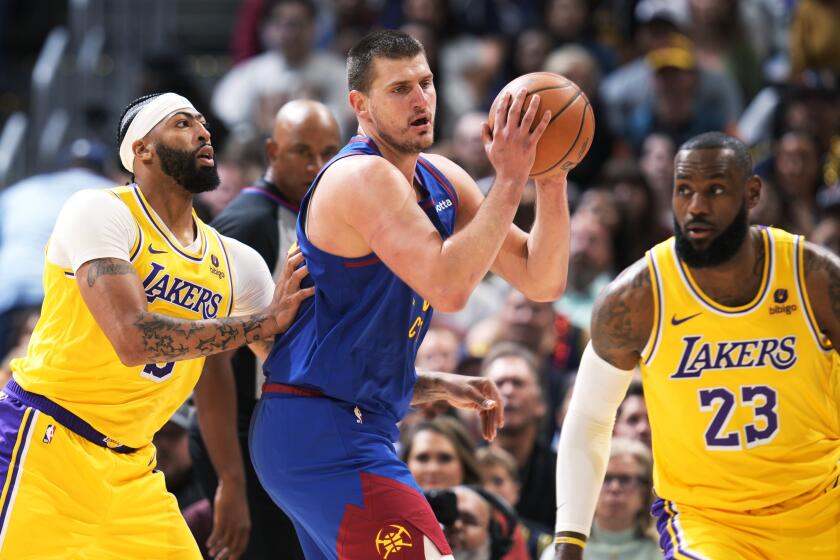Trainer clears up mystery of fillies racing with colts
To the casual observer of horse racing, last Saturday’s Preakness was the equivalent of the female cheerleader, coming off the sideline and smacking around the middle linebacker.
The girl beat the boys. Rachel Alexandra successfully tackled the testosterone. If Manny was watching, he might use it as a talking point with Bud Selig.
Females beating males makes horse racing somewhat unusual in sports, unless you are talking curling, sailing or dogs shows.
It is also unusual that, at the moment, two of the three bigger names in racing are female. That would be Rachel Alexandra and Zenyatta, along with their male counterpart, Kentucky Derby winner Mine That Bird, who, interestingly, has been gelded.
So, on the eve of Zenyatta’s return to racing today at Hollywood Park, after a seven-month absence, a discussion of the current distaff dominance seemed to be in order.
The perfect professor was John Shirreffs, who has trained the 5-year-old to her 9-0 record, including her victory in last year’s Breeders’ Cup Fillies Classic.
The questions for professor Shirreffs were designed to shed light on a topic has dominated racing news the last month.
Question: No filly had won the Preakness since 1924. Only three have won the Kentucky Derby. Why such infrequent challenges from the distaff side?
Answer: Part of it is the nature of the genders. The colts like to roughhouse. It’s like if you watch kids on a playground. The boys are in one corner wrestling, the girls in the other talking. If you bump a colt, he bumps back. If you bump a filly, she backs away.
Q: So what Rachel Alexandra’s connections said about their happiness over her No. 13 pole position was because she was clear of all that bumping and roughhousing?
A: Exactly. If Mike Smith (Zenyatta’s jockey) put her in the middle of roughhouse field and let her get bumped around, I wouldn’t be happy.
Q: Winning Colors was the last filly to win the Kentucky Derby, in 1988, and her trainer, Wayne Lukas, always said he ran her because she was big enough to run with the boys. Is size a huge issue?
A: Zenyatta weighs 1,200 pounds. Rachel Alexandra is a fairly big filly too. But remember, they may gain as much as 150 pounds between their 3-year-old season and when they run as 4-year-olds. Yes, you have to factor size in when you send a filly out against the boys.
Q: What about this stuff we constantly hear about how the males and females run against one another all the time in Europe. Why not here?
A: Europe is a different kind of racing. It’s all about the last quarter-mile. They sit and sit and then sprint. Our racing is rough-and-tumble stuff. Hard dashes to get to the front. Lots of banging around for position.
Q: Do fillies run when they are in heat? And how does that affect both them and the colts?
A: Zenyatta has run nine races. They are in heat once a month, so I suspect she has run when she is in heat, but I have never made that an issue or paid that much attention to it, so I’m not sure. Some trainers try to regulate it. They give their fillies something called Regu-Mate, which controls cycles. A lot of times, the filly stays on that for much of her racing career and then, when she is ready for breeding, she comes off it and is immediately in heat. I’ve never used it. I let things just occur naturally.
Q: If big and strong female horses can have some success against their male counterparts, why can’t the same thing occur with humans?
A: Human training systems are much more sophisticated than horse training. With a human, they can be trained to hit the wall (figuratively) and keep going. There is a logical outcome to that pain that they understand. You can’t train horses to do that. They get to that stage and look at you like, why is this happening.
Q: So strength and size and testosterone naturally kick in and, since male horses generally have more of that, producing more speed, that allows only the occasional filly well-enough equipped to take on the males?
A: For the most part, yes.
Zenyatta’s appearance Saturday at Hollywood Park, in the Grade II Milady Handicap, may spark a Memorial Day weekend buzz at a track that has had mostly negative noise so far in its summer meeting. It had to call off one race day because there weren’t enough horses to race, then recently went to a four-day racing week, presumably for the same reason.
Then, on Preakness day, its wagering system malfunctioned for the ninth race, forcing cancellation of all wagers from 33 out-of-state locations on the races.
Zenyatta’s attempt to win her second straight Milady, as well as her 10th race without a defeat, could successfully kick off a weekend that includes Sunday’s $100,000 Grade III Laz Barrera Stakes and Monday’s $250,000 Grade I Shoemaker Mile.
There were early signs of good things to come. On a quiet Friday afternoon in the barn of John Shirreffs, a good stare-down took place. In stable 85, Zenyatta measured the filly across the way in stable 75. Life is Sweet, likely second choice in the Milady, glared back.
It felt like testosterone.
--
More to Read
Get our high school sports newsletter
Prep Rally is devoted to the SoCal high school sports experience, bringing you scores, stories and a behind-the-scenes look at what makes prep sports so popular.
You may occasionally receive promotional content from the Los Angeles Times.







